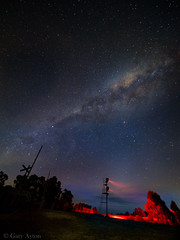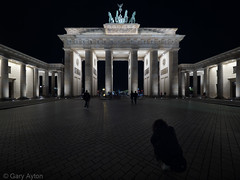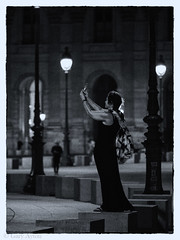Canon’s latest releases include:
- APS-C size 50D with 15mp = 38mp spatial resolution on a full frame
- full frame 5DMII with 21mp
- 1/1.7″ 5.7×7.6mm sensor (1/20th area of a full frame) G10 with 14.7mp = 292mp spatial resolution on a full frame!!
Is this megapixel madness or will these sensors really provide the resolution suggested by the number of megapixels and at what cost to image quality?
In analyzing this rather complicated issue, one should perhaps do a little bit of reading – check out the conclusions on Emil Martinec’s paper on noise, dynamic range, and bit depth of sensors.
Now, I’m not a mathematical expert, but his conclusions suggest:
- at high ISO, bigger sensors (not just bigger photosites), yield better image quality in terms of signal:noise ratio, and dynamic range
- at low ISO, small sensors and small photosites MAY perform better than large sensors in terms of signal:noise ratio – this is a little surprising to me but I must admit not being able to tell much difference at ISO 100 between my small sensor E510 images and my larger sensor Canon 1DMIII, so maybe there is some truth to this
- resolution is independent of sensor size but relates to number of megapixels BUT limited by the limits of the optical system used
Thus, on the surface then, at low ISO, there is not a problem with using lots of megapixels in a small sensor, HOWEVER, the real issue then becomes the optical resolution, and there are several features of this that come into play:
- diffraction limits – no matter how good a lens is, the laws of physics mandate that for a given wavelength of light, the best possible resolution is dependent on the aperture
- Airy disc diffraction spot size in microns for green light = 1.3 x aperture f/ratio (approx) – see Roger Clarke.
- your camera resolving power becomes limited by diffraction when your circle of confusion of your sensor (~2x pixel size in microns) becomes smaller than the Airy disc size
- thus on a 50D with 4.7micron pixels, diffraction limitation occurs at (4.7×2/1.3) = f/7, ie. at f/8 or smaller apertures you will lose your maximum resolution such that at f/11, you maximum possible resolving power is more likely to be as if your sensor pixels were 7.2microns which on this sensor size, equates to more like 8mp, and thus you save a 15mp size file to achieve only 8mp detail.
- see a calculator here
- in reality, this theoretical diffraction limit to resolving power is not usually reached because of other factors:
- camera shake – this is often THE NUMBER ONE issue that impairs resolution, making your $10,000 lens look like a $100 lens!
- this is why I believe all cameras should have a built-in IS like most Olympus dSLRs – you can always turn it off if you don’t need it!
- optical quality of the lens:
- lenses usually are sharpest when stopped down 1-2 stops from maximum aperture
- it is easier to make higher quality lenses at a similar price if they don’t need to cover as big an image circle – hence the very high resolution of lenses designed for Olympus Four Thirds which have resolutions some 3-5 times that made for 35mm film cameras
- lenses designed for 35mm film cameras generally allow resolution of 10-16mp on a full frame dSLR and tend to be quite soft in the corners in particular
- focus accuracy
Back to the original proposition:
The Canon 5D MII at 21mp is quite reasonable AS LONG as you use the highest quality lenses (the L primes and perhaps newer lenses as Canon makes them such as their new 24mm lens). Using other lenses are likely to only give 12-16mp detail in a file size of a 21mp image. I would have preferred the 5DMII to be 16mp which would be more optimised for current L lenses while giving better dynamic range and lower noise. In addition, at 16mp, it would have placed it nicely between the 10mp 1DMIII and the 21mp 1DsMIII.
- If I had the money, I would still consider buying the 5D MII as it would complement my 1D MIII very nicely indeed, as being full frame, it would give me access to ultra wide which the 1D MIII can’t do, a different angle of view with my tilt shift lenses, and the increased resolution MAY be of use for landscape work, etc where very large highly detailed prints may be more readily possible – although I probably really only need 10mp.
The Canon 50D MAY prove to be OK BUT only with high quality lenses designed for digital, otherwise you are probably only going to get 10mp detail but in a file size of a 15mp image. Unfortunately at this pixel size (the same as for Olympus dSLRs), only Olympus have an adequate range of dedicated lenses to match this spatial resolution in dSLRs. I would probably choose a 40D over a 50D unless tests prove otherwise, and the Olympus E3 or the Nikon D300 over either.
- since writing this post, another blogger has posted some comparisons which seem to show that the 40D images at high ISO appear to have more detail although more noise than the 50D, but if you really want low noise at high ISO, then the Nikon D3 (and presumably the D700) is far better than either the 40D or 50D
The Canon G10, I have grave doubts about its wisdom of having almost 15mp in such a small sensor!
For a start, as a result of its 1.7micron pixels, to get 15mp details with a perfect lens you must use apertures f/2.6 (1.7×2/1.3) or wider to account for diffraction limits and this means, even if its lens was perfect optically, you won’t get 15mp details from the lens as it is f/2.8-4.5 at its widest apertures. Indeed, if the lens were optically perfect, at f/4.5, the maximum detail possible would be for (4.5×1.3/2) = 2.9 micron pixels which equates to closer to a 6mp camera on this sensor size. In the process, the megapixel race means that Canon has foregone the opportunity to use larger photosites and gain improved dynamic range and less image noise. Personally, unless tests prove otherwise, I would prefer a 5-7mp camera in a sensor this size. See 6mpixel.org.
See Table 3 on this paper at Luminous Landscapes which shows the maximum resolving power of various sensor formats as limited by diffraction, in particular, at f/5.6:
- full frame 35mm maximum = 60mp (29mp at f/8, 16mp at f/11, 7mp at f/16, 4mp at f/22, BUT remember most 35mm optics struggle to do 16-22mp, thus they are lens-limited at f/8 or wider)
- APS-C maximum = 27mp (13mp at f/8 and 7mp at f/11, remember most lenses struggle to do 10-12mp on this sensor crop, thus, they too are lens limited at f/5.6 and wider)
- Four Thirds maximum = 1/4 of full frame = 17mp (8mp at f/8, 4mp at f/11)
- Canon G10 maximum = 1/20th of full frame = 3mp (6mp at f/4 and only 1.5mp at f/8!)
hmmm… sounds like an interesting project for someone to see if this is in fact true!











thanks gary for these valuable insights, I wonder if this could be tested by using a G10 at f/8 and seeing which image resolution you can drop it down to before you start losing detail. If indeed that is a 1.5mp image then the above is true.
What could explain this apparently fool hearty pixel race that Canon is trying desperately to win/lose (sic).
My only thought is that they are counting on the popularity of Web-based display of images, together with small-sized prints so that IQ problems aren’t so obvious?
Why do you think Panasonic is increasing the µ4/3rds sensor size to 12.1Mp?
Have you heard of anything new about the 12.1Mp sensor’s technology that may have prompted this change?
I like your BLOG and the articles you write –Thanks.
Thank yuu for your comments on the Canon G10. It will be interesting to see how it actually performs at high ISO ratings (or even at 400 ISO). Retaining the optical viewfinder is a big plus IMHO as there would be times when the display would be hard to see.
By the way, you wrote that “it would compliment my 1D MIII very nicely indeed.” Please don’t think me a pedant if I say that the word should be “complement”
Thanks for pointing out my grammar error Alan.
And yes, an optical viewfinder can be very useful, and I hope Olympus or Panasonic create a Leica-like rangefinder version in their Micro Four Thirds system, but suspect they may well settle for EVF only.
RE: g10
A year ago I traded in my Canon g5 for a g10 – with great expectations.
So far the results have been disappointing.
I barely see any improvement from the g5,l in fact in low light conditions (which I like to shoot) I think the g5 was better.
In ‘perfect’ daylight conditions the g10 seems to do well, but I have still not been able to get good landscape results printed beyond 11X14″
I think the ‘pixel packing’ was a marketing move by Canon and the test that Luminous Landscape did comparing the g10 to the Hasselblad really did a disservice to the public.
My next move, I think is to try a Nikon d5000 matched with the 35mm 1.8 lens (this kit is in my budget).
Any comments?
Hi Dave, great quality, large prints of landscapes can be quite demanding needing a combination of image detail (sensor pixels balanced with optical resolution optimised by accurate focus and zero camera shake), dynamic range (potentially enabled using ND gradient filters, or HDR techniques), and adequate depth of field (traditionally enabled by using a tilt lens).
The G10 is OK for its size, but has limitations on most fronts as you have found.
Ideally, a full frame dSLR with tilt lens on a sturdy tripod would be the way to go, but this is very expensive, heavy and bulky.
Any of the modern cropped sensor cameras – Nikon, Canon, Olympus, Micro Four Thirds will do a reasonable job (and better than a G10) and you would probably be needing to use f/5.6-8 for best optical resolution and depth of field, so a fast f/1.8 lens is probably not needed. Even the Olympus kit lenses will do an adequate job at resolution at these apertures.
If you are going to hand hold the lens, an image stabiliser should be considered – perhaps an Olympus E600 kit or a Sony kit as it sounds as though the Micro Four Thirds cameras are a little out of your budget – but the Panasonic GH-1 does have a nice uncropped 16:9 panoramic aspect ratio which I love as well as a swivel LCD which is handy for tripod use.